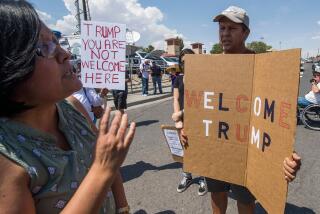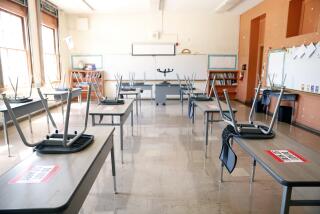School Teaches Students Mediation Skills
- Share via
CAMBRIDGE, Mass. — It’s a long way from clapping the erasers after school as a punishment for bad behavior.
Mediation and negotiation have become watchwords for many U.S. educators. With school violence on the rise, teachers are turning to these means to maintain classroom harmony.
A school in Cambridge has been teaching a pilot class in mediation to a portion of its high school freshmen for several years. The class may soon become a requirement for all. Its instructor, John Silva, director of safety and security in the Cambridge school system, also runs a mediation program that uses both teachers and students as mediators.
Over the past three years, Silva has trained 20 students and 15 teachers to act as mediators in classroom and schoolyard clashes at the 2,600-student Cambridge Rindge and Latin School.
The mediation program helps by “pulling students out of the hallways, where the peer pressure is . . , and giving them an opportunity to sit down and think maturely,” Silva says.
Only two out of 180 cases mediated so far were not resolved to the satisfaction of all parties.
All the cases involved students. Other parties have been other students, teachers, administrators and even parents. Given the school’s inner-city situation and the 70 nationalities represented in the student body, Silva says, the program’s success is remarkable. He credits that to the students’ perception that the process is fair. Participation is voluntary.
Tough kids, especially, do not respond well to disciplinary action, Silva says. Ultimatums are seen as threats and opportunities to rebel.
Clarence Gaynor, one of the program’s two coordinators, says that the mediation efforts began “in a reaction mode” but have become preventive. “We need to unload the extra baggage we bring to school sometimes . . . and get back to the business of learning and education,” Gaynor says.
The suspension rate at the Cambridge school has dropped since the mediation project began. Although several factors may be involved, Silva and his mediators can claim at least partial credit for the reduction. For one thing, the mediation program works at resolving a conflict before it breaks out in violence or disruptions that end in suspension.
About 30 teachers and administrators from across the country who wanted to learn how to use and teach conflict-resolution skills attended a workshop last summer sponsored by Boston-area Educators for Social Responsibility (ESR).
The workshop, run by former teachers William Kreidler and Stephen Weimar, shows participants how to enlist students--from kindergarten to 12th grade--as peacemakers in the classroom.
Kreidler began teaching in the Boston public schools in 1974, “a banner year for conflict.” That was the year that Boston schools were desegregated, and racial tension was at its height. He says, “I had to deal with conflict in order to get to the reading and the writing and the math.”
What began as an interest in survival skills for himself became something else when he realized how eager his second-graders were to learn peacemaking skills--and how easily they applied them. Kreidler says peacemaking skills “give kids a framework to look at their community and even international conflicts” in an objective way.
The techniques aim to reduce the number of arguments and fights by encouraging children to see things from the other kid’s point of view, then to resolve any dispute through negotiation or mediation.
Kreidler uses simple activities that can be taken back to the classroom.
At one workshop, for instance, two teachers role-played an allowance dispute between a mother and her 11-year-old son.
To hoots and howls from the rest of the group, “Tom” scowled and avoided eye contact with “Mom,” while “Mom” defended her position with a mother-knows-best attitude. Eventually a compromise was reached, giving “Tom” a raise in his allowance if he gave “Mom” some additional help and did all his chores regularly.
“The field of conflict resolution cuts across the political spectrum,” attracting teachers of all ages and teaching styles, Kreidler says. In the past year, the Boston ESR chapter, staffed primarily by full-time teachers, has given about 50 teacher workshops in conflict-resolution theory. The feedback has been excellent, he says.
Eva Braz, a sophomore at Cambridge Rindge and Latin School, took the school’s mediation class last year. She and five of her classmates then became school mediators. She has since mediated four disputes.
Eva says that when students are given a choice between suspension and mediation, “all of them want to go to mediation; no one wants to get suspended.”
But disputants also know, she says, that “if we don’t get an agreement or if they don’t want to talk, we send them back to the house masters,” where they are encouraged to try again to reach a mediated agreement. If they do not, they face suspension.
Eva says role-playing in mediation class was helpful. She learned to explain the rules of mediation, to ask questions and to find out what the individuals involved want to get out of the mediation session: “Do you want to be friends? Or just say ‘hi’ in the hallway? Or not speak to one another?” she asks participants at the beginning of each session.
Her involvement in the mediation program has paid off in other ways too. “Sometimes when I have problems myself, I think about it. It helps me out too.”
More to Read
Sign up for Essential California
The most important California stories and recommendations in your inbox every morning.
You may occasionally receive promotional content from the Los Angeles Times.













